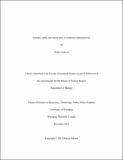| dc.contributor.author | Jackson, Shayla | |
| dc.date.accessioned | 2023-12-14T20:14:11Z | |
| dc.date.available | 2023-12-14T20:14:11Z | |
| dc.date.issued | 2023-12-10 | |
| dc.identifier.citation | Jackson, Shayla. Coyotes, cattle, and native prey in southwest Saskatchewan; A thesis submitted to the Faculty of Graduate Studies in partial fulfilment of the requirements for the ... Master of Science in Bioscience, Technology, [and] Public Policy Program. Winnipeg, Manitoba, Canada: University of Winnipeg, December 2023. DOI: 10.36939/ir.202312141400. | en_US |
| dc.identifier.uri | https://hdl.handle.net/10680/2125 | |
| dc.description.abstract | Native grasslands are home to a disproportionate share of species at risk, and typically consist of a mosaic of ranchland and protected parkland. Livestock carcasses can attract coyotes and potentially subsidize the coyote population or increase depredation, which is a concern to ranchers in southwest Saskatchewan. A subsidized predator population may increase pressure on native prey species through apparent competition. In this thesis, I investigated the relationship between coyotes, cattle and native prey. In the second chapter, I used molecular methods to test how commonly coyotes consumed cattle and species at risk, and how geographic factors affected the presence of cattle versus deer in coyote diet. Deer and cattle were the most common food items. Scat containing cattle was typically found closer to a boneyard and the bison enclosure, whereas scat containing deer was typically further from a boneyard and the bison enclosure. Different individual coyotes may be consuming cattle versus deer and coyotes consuming cattle may show different travel behaviour than coyotes consuming native prey. However, I found no evidence that coyotes pose a direct threat to species at risk during the winter. In the third chapter, I observed coyotes during summer to test whether coyotes obtained direct and/or indirect benefits from cattle pastures, and how cows responded to the presence of coyotes. Coyotes hunted native prey and specifically ground squirrels more commonly than cattle, showing that they obtained indirect benefits from the use of cattle pastures. Cows responded to coyotes defensively, and although observations of coyotes approaching individual calves, rushing cow-calf herds, or harassing females for afterbirth were uncommon, these observations, combined with the coyotes’ scavenging from cattle carcasses, indicate that coyotes also benefit directly by consuming cattle or cattle by-products. Further work identifying individual coyotes would help to determine what proportion of the population is being subsidized by cattle and factors that might predispose individual coyotes to depredation. | en_US |
| dc.description.sponsorship | Natural Sciences and Engineering Research Council of Canada | en_US |
| dc.language.iso | en | en_US |
| dc.publisher | University of Winnipeg | en_US |
| dc.rights | info:eu-repo/semantics/openAccess | en_US |
| dc.subject | Coyote -- Ecology | en_US |
| dc.subject | Coyote -- Food | en_US |
| dc.subject | Cattle | en_US |
| dc.subject | Grasslands | en_US |
| dc.subject | Native prey | en_US |
| dc.subject | Species at risk | en_US |
| dc.subject | Behaviour | en_US |
| dc.title | Coyotes, cattle, and native prey in southwest Saskatchewan | en_US |
| dc.type | Thesis | en_US |
| dc.description.degree | Master of Science in Bioscience, Technology, and Public Policy | en_US |
| dc.publisher.grantor | University of Winnipeg | en_US |
| dc.identifier.doi | 10.36939/ir.202312141400 | en_US |

